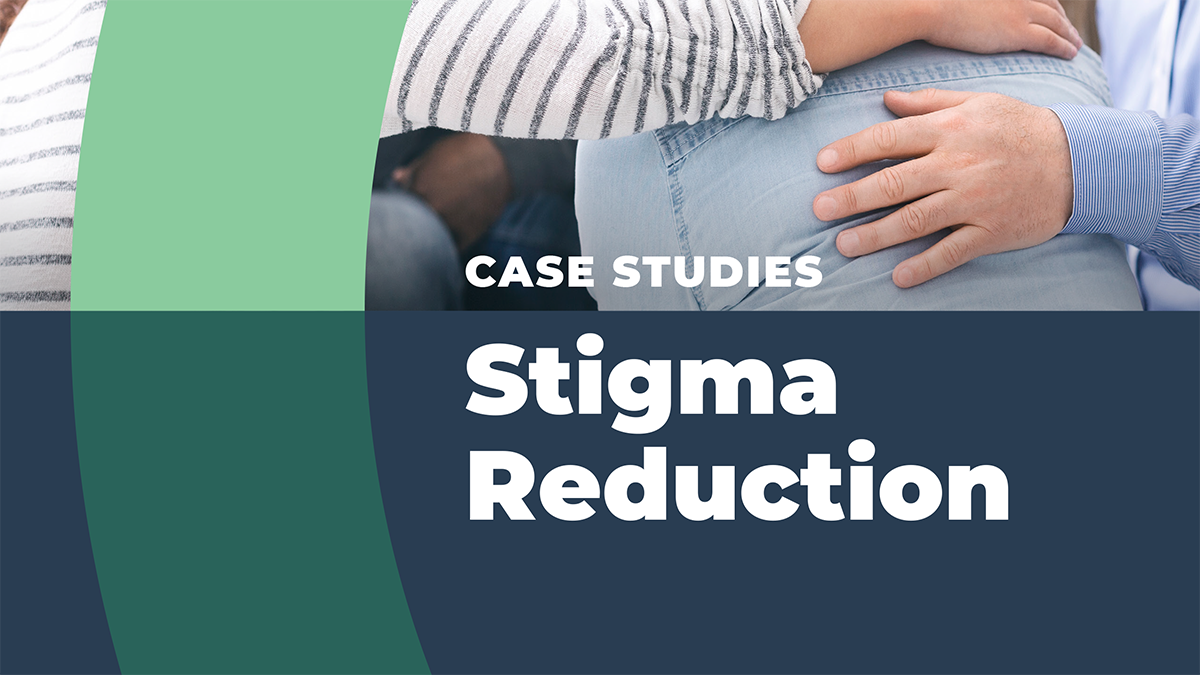At a glance
Learn more about the importance of stigma reduction as a prevention strategy from case studies from Overdose Data to Action in Vermont.

How can reducing stigma help prevent drug overdose?
Case Studies: Stigma Reduction - Full report
The drug overdose epidemic in the United States remains a critical public health issue. Stigma can negatively affect access to health care, such as initiation of medications for opioid use disorder (MOUD).1 Stigma is a process where people with certain social identities are labeled, stereotyped, and devalued, leading to discriminatory behavior and internalized shame.2 Rates of stigma toward people who use drugs are high and well documented among healthcare providers and the general public.134
Confronting stigma at multiple levels and creating a culture of change is possible despite the pervasiveness of stigma among the public and healthcare providers.456
To reduce stigma among those working with people at high risk of overdose, health departments can promote these three strategies to healthcare providers and the general public:
- Changing language. Healthcare providers and the general public can use "person-first" terminology to describe people who have experienced an overdose or are at high risk of overdose and those who are affected by it. Increasing use of nonjudgmental language is key. Healthcare providers and the general public may need training on accurate and appropriate terminology.
- State policies. Policies can promote and expand comprehensive treatment programs, especially in criminal justice systems. The public can also support and advocate for broad access to MOUD.
- Training. Stigma reduction training helps healthcare providers develop the appropriate skills to work effectively with stigmatized groups. For example, motivational interviewing is a type of counseling style that uses constructive conversation to elicit behavior change. Motivational interviewing training enables people in frequent contact with those with opioid use disorder to assess their readiness for behavior change and connect them with appropriate resources (e.g., engage persons with harm reduction techniques or linkages to care7). Healthcare providers can also receive additional training to increase their knowledge and confidence in MOUD or to provide links to other services/treatment.
Case study snapshots
Case 1: Motivational Interviewing and Compassion Training – Vermont
- Training purpose: To increase positive interactions between emergency personnel and people who have experienced an overdose or are at high risk of overdose
- Intended audience: Staff in emergency departments, emergency medical services, and Department of Corrections
- Length: 4.5 hours
- Number of trainees per session: 12–25 people
- Content: Screening, brief intervention and referral to treatment, and motivational interviewing
- Format: Instructor-led learning, self-led learning, interactive role-play with standardized patients
Case 2: Stigma/Harm Reduction Training – Vermont
- Training purpose: To improve understanding of harm reduction approaches/principles and of challenges and stigmatization facing people at high risk of an overdose, and to provide tangible language and phrases emergency personnel can use when encountering people who have experienced an overdose or are at high risk of overdose
- Intended audience: Staff in emergency departments and emergency medical services, Department of Corrections, and community partners that work with populations vulnerable to overdose
- Length: 2 hours
- Number of trainees per session: 20 people
- Content: Overview of harm reduction and related principles, syringe services programs (SSPs), harm reduction interventions, stigma reduction strategies, examples of tangible destigmatizing language, stories from people who formerly used drugs, engagement with people at high risk of overdose, and local and state resources
- Format: Instructor-led learning with meaningful digital content (e.g., videos featuring persons with lived experience sharing how a substance use disorder [SUD] impacted them and perceptions/misconceptions about SUDs)
For more information about Vermont's Motivational Interviewing and Compassion Training and Vermont's Stigma/Harm Reduction Training, check out the full report, Case Studies: Stigma Reduction.
- Stone, E. M., Kennedy-Hendricks, A., Barry, C. L., Bachhuber, M. A., & McGinty, E. E. (2021). The role of stigma in US primary care physicians' treatment of opioid use disorder. Drug and Alcohol Dependence, 221, 1-7. https://doi.org/10.1016/j.drugalcdep.2021.108627
- Tsai, A. C., Kiang, M. V., Barnett, M. L., Beletsky, L., Keyes, K. M., McGinty, E. E., Smith, L.R., Strathdee, S.A., Wakeman, S.E., & Venkataramani, A. S. (2019). Stigma as a fundamental hindrance to the United States opioid overdose crisis response. PLOS Medicine, 16(11), 1-18. https://doi.org/10.1371/journal.pmed.1002969
- Barry, C. L., McGinty, E. E., Pescosolido, B. A., & Goldman, H. H. (2014). Stigma, discrimination, treatment effectiveness, and policy: public views about drug addiction and mental illness. Psychiatric Services (Washington, D.C.), 65(10), 1269–1272. https://doi.org/10.1176/appi.ps.201400140
- Kennedy-Hendricks, A., Barry, C. L., Gollust, S. E., Ensminger, M. E., Chisolm, M. S., & McGinty, E. E. (2017). Social stigma toward persons with prescription opioid use disorder: associations with public support for punitive and public health–oriented policies. Psychiatric Services, 68(5), 462-469. https://doi.org/10.1176/appi.ps.201600056
- Kelly, J. F., & Westerhoff, C. M. (2010). Does it matter how we refer to individuals with substance-related conditions? A randomized study of two commonly used terms. International Journal of Drug Policy, 21(3), 202-207. https://doi.org/10.1016/j.drugpo.2009.10.010
- Olsen, Y., & Sharfstein, J. M. (2014). Confronting the Stigma of Opioid Use Disorder—and Its Treatment. JAMA, 311(14), 1393-1394. https://doi.org/10.1001/jama.2014.2147
- Rollnick, S., & Miller, W. R. (1995). What is motivational interviewing? Behavioural and Cognitive Psychotherapy, 23(4), 325-334. https://doi.org/10.1017/S135246580001643X
